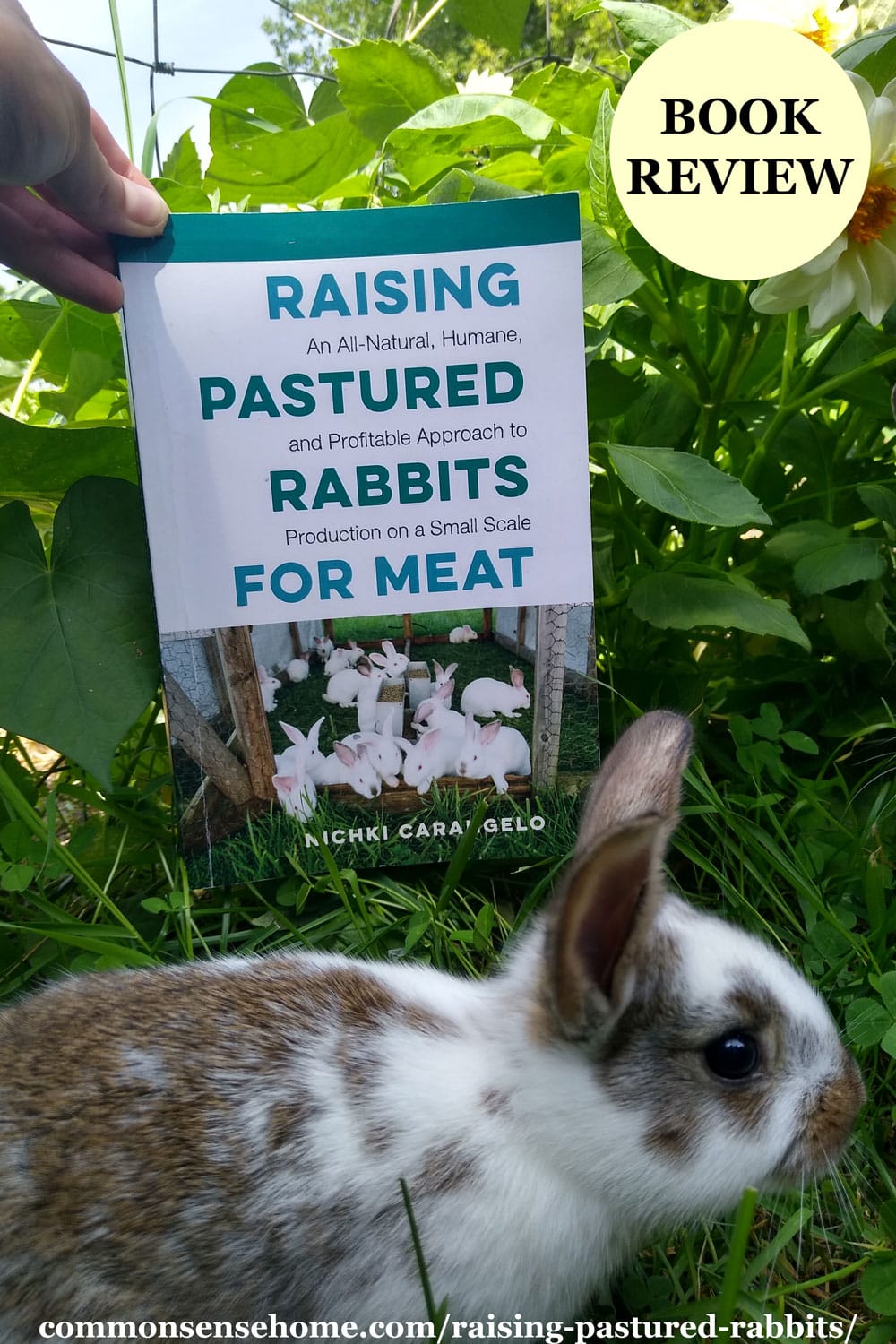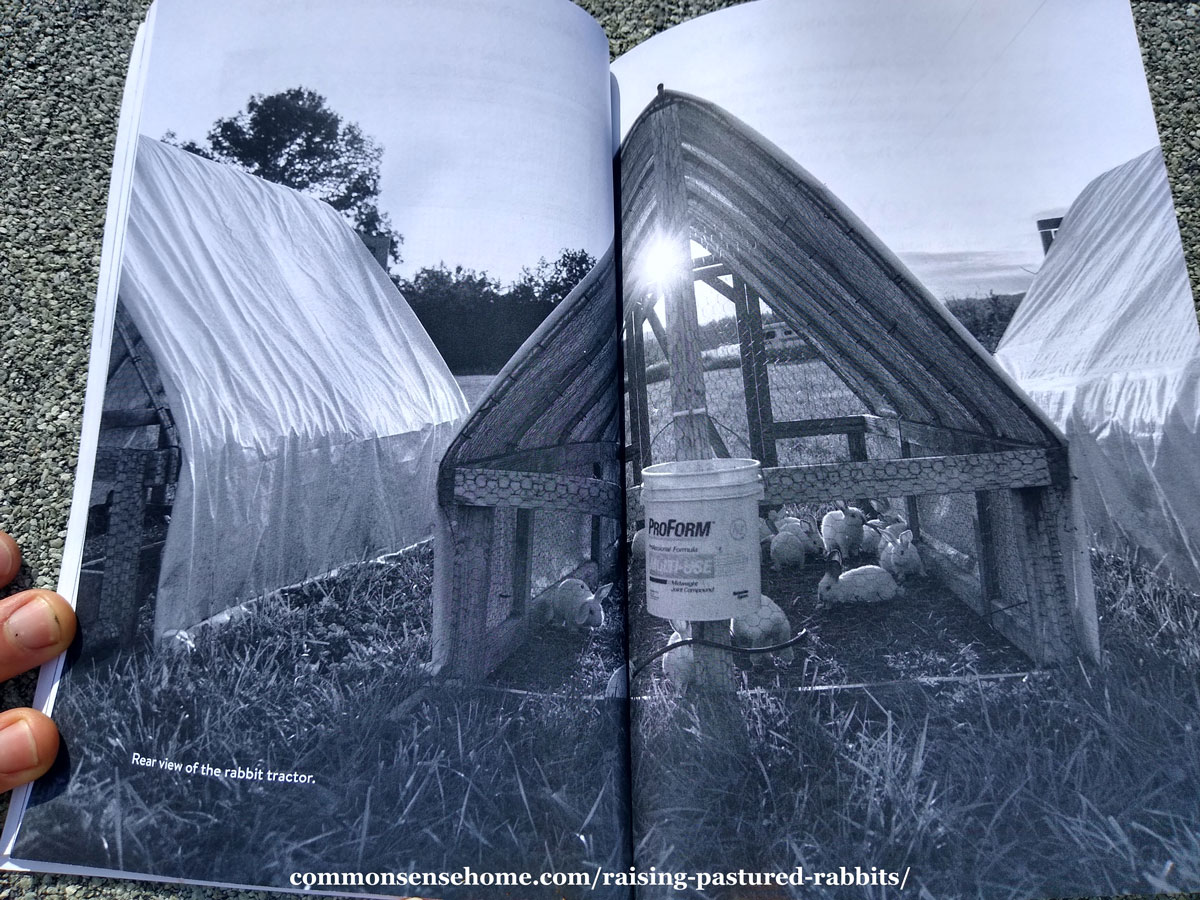Raising Pastured Rabbits – Book Review and Recommendations
“Raising Pastured Rabbits For Meat” by Nichki Carangelo is all about raising meat rabbits for profit in a pasture based system.
Raising rabbits is a rewarding and cost effective source of meat. They are an ideal addition to many homesteads because they:
- reproduce quickly
- take up little space
- reach a butchering maturity as early as twelve weeks

Raising Pastured Rabbits – What's in the Book
This book covers:
- why the author chose to raise rabbits
- how they raise rabbits and the trial and error that led to this method
- basic rabbit care information
- comprehensive sections on processing, marketing, and finances related to raising rabbits for profit
There is no one right way to farm, and the author mentioned this several times throughout the book. We each need to figure out the best way to use our resources. What works for one person may not work for another.
The book has good information on rabbit care, plus reminders to be gentle with yourself on your farming journey.
Stewardship
I was impressed with how thorough the author was in the health and disease section. There's detailed information on symptoms of various ailments, their treatments, and candid information on what not to do.
I especially appreciated the quote she included from The Small Scale Poultry Flock by Harvey Ussery, regarding culling animals who are sick or have undesirable traits.
“We are stewards of our animals and as such it is in our best interests and theirs, to breed for strong, healthy animals and to cull those animals who do not meet our standards of health.”
The book also mentioned a great “new to me” resource – Medi Rabbit. It's chock full of information about all things relating to rabbits.

Pastured Rabbit Cages and Tractors
I also greatly appreciated her information on various types of cages and rabbit tractors in the book. I was pleased to see that she mentioned why colonies may not be an ideal solution for everyone, even though some people do have success raising their rabbits in this manner.
Personally, I would not recommend colonies for someone who is just beginning raising rabbits. There are too many issues that can arise, especially regarding the health of the animals.
For an experienced producer who is certain of the hardiness of their animals, it could be a time saving solution.
I liked that she included the exact specifications of the cages and the barn she houses her breeding rabbits in, plus:
- where to find the design she based her rabbit tractors off of
- directions and dimensions for building her nest boxes
Breeding Rabbits
The breeding section was excellent. I was impressed that she mentioned how adding extra lighting in winter can help with making sure does are receptive to breeding.
One thing I wish she had mentioned in this book was that re-breeding the rabbit after 24 hours has passed instead of waiting 10-14 days to palpate for kits.
Time is money, so if you test breed a rabbit after 24 hours, then you’re less likely to find out two weeks later that the initial breeding wasn’t successful. I did like that she included how heat often results in weak sperm.
In general, if it’s hot, we do not breed our rabbits as it is not worth stressing the rabbit’s bodies. Heat stress is much worse for rabbits than cold stress which is why on a small scale one thing you can do on hot days is give your rabbits a frozen water bottle or soda bottle.
Pastured Rabbit Hoop Houses
Throughout the book she mentioned why they chose to raise their breeding stock in a covered hoop house (much like a barn) rather than solely on pasture as some people do.
As I suspected, it is much harder to keep kits alive in a pasture situation, because their nests aren’t protected from the elements or predators. It’s also harder to keep them healthy since coccidia occurs from fecal to oral contact and rabbits can come in contact with wild rabbits that are carriers of pasteurella which can quickly wipe out your rabbits.
The more kits survive to be sold for meat, the more profitable your enterprise. We rarely lose kits in our set-up except when it is extremely cold (hovering at or below 0 Fahrenheit).
She raises her weanlings from weaning to slaughter in modified chicken tractors so that they can still forage, but are protected from predators.
She has found that raise rabbits on pasture only is not cost effective. Their grow-out time increases by months.
We keep our weaned rabbits in chicken wire cages, but we pick all our rabbits quantities of clover, grass, and plantain.
Note: please do not feed your rabbits lettuce or items from the brassica family. They cause digestive issues that can lead to death.
Rabbit Handling
One thing I did not like was in her handling section regarding picking up kits solely by their haunches. Local rabbit growers told me this can cause intestinal damage.
Similarly, picking rabbits up solely by their scruff without supporting their body may cause the rabbit to stretch so their back literally snaps.
Another way to calm a frightened rabbit (not mentioned in the book) is to tuck their head under your arm so that they feel secure.
I did like that she mentioned catching rabbits in a rabbit tractor when they’re frightened will just lead to frustration for the farmer and injury for the animal. It's best to take a step back and wait until they have calmed again before trying to catch them.
It would have been useful for her to include some pictures of the sexing process. I recognize that rabbit photos are a challenge, but it would have made a good addition to the book.
Twigs to avoid feeding to rabbits (like cherry and walnut) should have also been included.
The author mentioned that rabbits can get sore hocks, but not remedies for the issue. You can purchase plastic mats for your rabbits to sit on that greatly reduce this problem.
They are easy to sanitize and really hold up to use. (This is one that is similar to the one we have for our rabbits.)
We tried ceramic tiles and wooden slats for our rabbits, but both build up with urine and poop.
Rabbit Raising Resources
I am glad I had the opportunity to read this book. It will more help us use our rabbit raising resources more effectively.
It also confirmed for me that rabbit cages are the best option for us right now. (We keep the cages in a shelter outside during warm weather and in inside the barn during the winter.)
For more rabbit information, my favorite book on the topic is Raising Rabbits by Ann Kanable.
Storey’s Guide to Raising Rabbits is another excellent resource.
Daniel Salatin of Polyface Farms also raises pastured rabbits.
More Homestead Animal Posts
Check out more articles on homestead animals on the Homesteading page, including:
Meat Rabbits – What you need to know about raising rabbits for meat
Rabbit Breeds, Basic Rabbit Care and Interesting Rabbit Facts
Meat Chickens – Best Breeds, Care and Troubleshooting Tips

